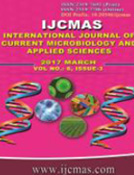


 National Academy of Agricultural Sciences (NAAS)
National Academy of Agricultural Sciences (NAAS)

|
PRINT ISSN : 2319-7692
Online ISSN : 2319-7706 Issues : 12 per year Publisher : Excellent Publishers Email : editorijcmas@gmail.com / submit@ijcmas.com Editor-in-chief: Dr.M.Prakash Index Copernicus ICV 2018: 95.39 NAAS RATING 2020: 5.38 |
Thirty nine, out of 46 acid tolerant Lactobacillus spp., isolated from traditional dairy products, fermented foods and human fecal samples, were preliminary identified at genus level as Lactobacillus and evaluated for probiotic properties which included bile tolerance, simulated gastrointestinal juice, cell surface hydrophobicity, cell auto-aggregation, co-aggregation and bile salts hydrolase activity. Thirty three isolates could resist well at 1.5 % bile while 26 isolates showed tolerance towards simulated gastric juice (pH 2.0, 3 h of incubation) and simulated pancreatic juice (pH 8.0). Only 9 isolates could exhibited >50% cell surface hydrophobicity wherein LBF89, LBF91 and LBF90 exhibited highest cell surface hydrophobicitywith n-hexadecane i.e. 73.47±2.15 %, 72.25±1.69 % and 71.65±1.90 % respectively. LBF89 showed highest cell auto-aggregation (50.67±1.08%) while least auto-aggregation was demonstrated by LBF 11. LBF 20 exhibited highest mean co-aggregation 50.17 % with E. coli, L. monocytogenes, S. abony and S. aureus. S. abony was the highly encountered pathogen with an average value of 31.14 % ofco-aggregation. Highest bile salt hydrolase activity was observed in LBF 89 and LBF 91with sodium taurodeoxycholate. Bile salt hydrolase activity was quantitatively determined wherein the highest activity i.e.7.21±0.10, was observed in LBF 89 isolate followed by LBF 91 with 6.56±0.10 as total enzyme activity. Both the isolates were identified using PCR as Lactobacillus plantarum but distantly placed in the phylogenetic tree. Among the selected isolates, LBF 89 and LBF 91 showed the best probiotic potential with high tolerance to bile, simulated gastrointestinal juice and exhibited high bile salt hydrolase activity. Both the isolates possess application potential for functional foods and health-associated products.
 |
 |
 |
 |
 |